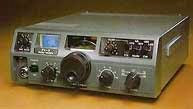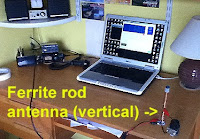Author Archive
 160m indoor loft antenna
160m indoor loft antenna
Some years ago G6ALB and I wanted a simple talkback link that we could use when co-operating on experiments. We were 3km apart with Andrew being in the next village. We immediately thought about simple AM rigs for topband (160m).
As I had no 160m antenna, I built the design linked here. This antenna works well with best WSPR spots being over 1000km.
We decided that topband was too noisy for our simple AM rigs for our intended purpose. The noise floor at both our locations is very high on 160m. I have since moved QTH but we are still thinking about this link. We are now 3.3km apart. Probably 6m would be a better choice as less noisy and we both have vertical antennas.
See https://sites.google.com/site/g3xbmqrp3/antennas/160m_loft_ant .
 Amateur VLF DXing
Amateur VLF DXing
Operating an amateur station at VLF is a very specialised area of experimentation. There are basically 2 different threads (1) earth-mode or utilities assisted earth-mode with propagation mainly along or close to roads and (2) radiated DXing in which a VLF signal is actually radiated and propagated to great distances. With (1) I have managed 6km with QRSS3 with 5W from a TDA2003 audio IC at 8.97kHz. Earth-mode gear can be low powered and simple to build.
 |
| VLF amateur signals |
With (2) the Atlantic Ocean has now been crossed, i.e. quite remarkable distances with amateur powers and antennas. Usually very large loading coils are needed and making these can be “challenging”. As high voltages are likely, great care is needed. Of course, most DXing is done with very long stable transmissions in very narrow bandwidths. Most amateur VLF gear is home made with free PC software to allow signals to be seen. Casual listening is not effective. Most operation is now around 8.300kHz as this is unallocated in many countries.
News of VLF activity may be found at https://sites.google.com/site/sub9khz/ .
 Yaesu FT7 HF transceiver
Yaesu FT7 HF transceiver
 |
| Yaesu FT7 – a true classic |
Way back in about 1979 I owned a Yaesu FT7. This was a 10W HF rig using a modular construction. It was a beautiful radio with a lovely, quiet receiver. It is probably the best radio I have ever owned and used. It predates WARC bands and only covered one 500kHz part of the 10m band and the non-WARC bands from 80m-10m. Today, it looks large. It was an analogue radio – no memories, no synthesisers – just a very good HF radio transceiver. I worked all over the world with mine using QRP SSB and simple, low, wire antennas and no beams, mainly on 10m. In those days, most (all?) USA SSB was above 28.5MHz. Canadians were mainly below 28.5MHz.
My little FT817 has more bands and modes and is about 1/10th of the size.
I can thoroughly recommend the FT7, but they are very hard to find. A later version was 50W pep and had full 10m coverage in 4 x 500kHz sections. The FT7 was a “real” radio – no gimmicks, just a truly amazing rig. Many who owned them and sold them (like me) later regretted selling them. As they say, these rigs are “keepers”. If you find one you are unlikely to be disappointed. Also, the handbook was complete so you could service it and not an SMA component in sight!
 Miracle Whips and derivatives/copies
Miracle Whips and derivatives/copies
A 56 inch long whip can only behave like a 56 inch whip. This is a basic law of physics. What the Miracle Whip (MW) and its derivatives do is match this whip on the HF and VHF bands. With a decent ground or counterpoise wire the MW may be only a couple of S-points down on a “decent” antenna on the higher HF bands. They work reasonably well and, in the past, I used my MW quite a bit, even from indoors. They are definitely NOT a miracle antenna, although they are not too bad. Since the owner, a Canadian called Robert, died there have been a few newcomers in the market.
Would I buy one today? Probably not. I have had better results with small loops. As a simply deployed mainly RX antenna they make an ideal companion for an FT817 or similar. Their beauty is their simplicity. If you want optimum performance in a small antenna there are better solutions. Small loops seem to work better, but then bandwidth becomes very narrow although loops don’t need grounds or counterpoises to work well. Personally, at QRP levels I’d use a loop every time.
As Wheeler showed years ago, efficient small antennas are reactive and unless losses are minimised, efficiency suffers. This is a fundamental limitation. Although high permeability ferrites and high permittivity ceramics can help to alter the size of space near an antenna and “magnify” the effective size of small antennas, the effect is small unless there is a lot of ferrite with high permeability or a lot of ceramic with a high permittivity. In theory, a tiny antenna can be very efficient but you’d need superconductors and lossless capacitors! At the moment, sadly, neither are practical to mortals!
See https://sites.google.com/site/g3xbmqrp3/antennas/mwhip .
 Microvert antennas and similar
Microvert antennas and similar
It looks like the Microvert antenna may have originated in Japan? The Microvert is a very compact antenna. Some believe the coax is a major part of the radiating system. Having never tried this sort of antenna I am unable to comment. This was posted to the Microvert Yahoo group earlier:
Whether you believe it’s the coax radiating or not, this is still interesting:
The Super Rad Antenna (Induced Secondary Radiation Antenna)
There are other websites about SRA (secondary radiation antenna), but unfortunately all in Japanese. Its definetly a Japanese thing!
I have all the parts required here to make one of these. Whether you believe its the coax radiating or not the results will be interesting.
Rob
M0RZFPS. My old 10m/12m modified microvert gives a good SWR.
 Pedestrian portable DXing
Pedestrian portable DXing
In the past, when fitter, I had a lot of casual fun working real HF DX with simple rig mounted antennas and batteries. In fact I have worked some impressive DX with QRP SSB using just the whip on the rig, mainly on 15m and 10m SSB. Best DX includes South America from my late mother’s back garden on 15m SSB with the FT817 at 2.5W setting
One advantage is you can move the rig and antenna of optimum signal on receive. A small counterpoise wire is pretty essential to get best results. When fit again I’d like to do more of this, but currently my poor health is getting in the way.
Others, far more dedicated than me, have worked far better DX. Some get up early to work Australia from beaches with QRP on 20m. I have also worked a long way into Europe on 2m FM with QRP. 6m SSB Es is certainly workable with small rig mounted antennas.
I think you have to believe than this is possible (HF DX) and it will happen. Think how strong some signals are. On the higher HF bands a base loaded, or better still a centre loaded, whip is not that far down on a full sized vertical.
See https://sites.google.com/site/g3xbmqrp3/hf/pedestrian .
 Ferrite rod transmitting antennas?
Ferrite rod transmitting antennas?
OK, I only tried this with WSPR and with low power, but at my old QTH I had a good deal of success using a small ferrite rod as a TX antenna on some HF bands. As long as the ferrite is not in saturation there is no good reason why it should not work. Most problems will occur if the antenna is driven with too much power.
See the link for more details. I have no idea about this ferrite rod’s properties but I think it was a fairly standard piece of ferrite rod and nothing too special at all.
Since being in hospital for 3.5 months and moving QTH I have not been able to find the ferrite rod to repeat the tests. My wife moved most of my stuff and it is probably deep in a box somewhere! At some point I guess it will just turn up.
See https://sites.google.com/site/g3xbmqrp3/antennas/ferrite_tx .















